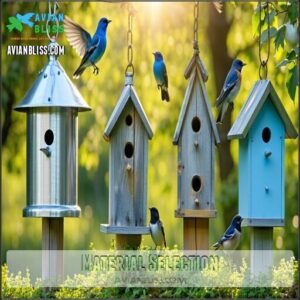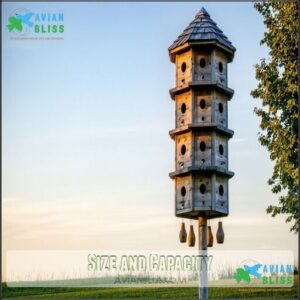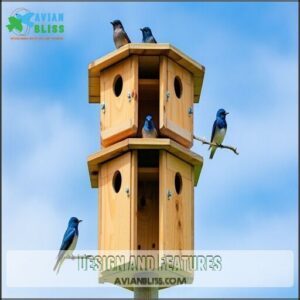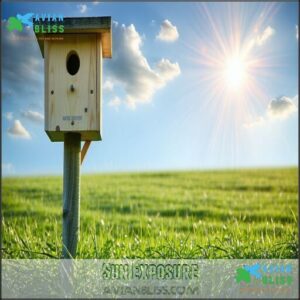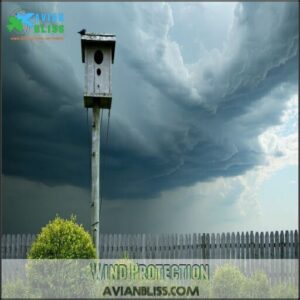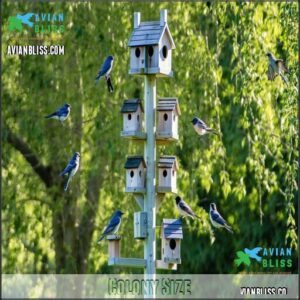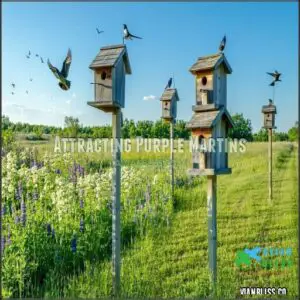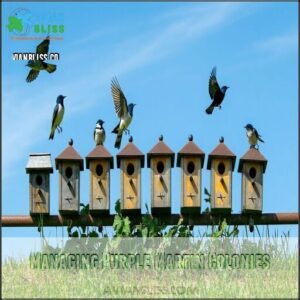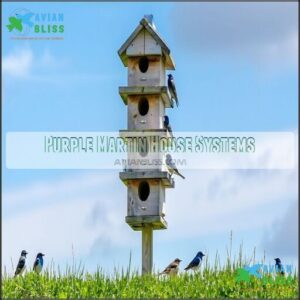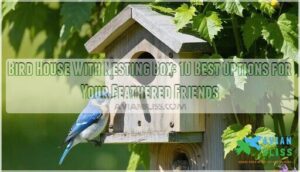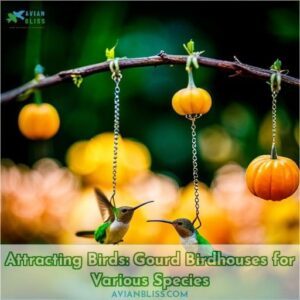This site is supported by our readers. We may earn a commission, at no cost to you, if you purchase through links.
 A purple martin bird house system is more than just a set of birdhouses—it’s a carefully designed habitat.
A purple martin bird house system is more than just a set of birdhouses—it’s a carefully designed habitat.
Start with durable materials like aluminum or UV-resistant plastic to withstand weather. Each compartment should be at least 6×6 inches, with crescent-shaped entrances to keep predators out.
Place the system in open areas, 12-20 feet high, with plenty of sunlight and at least 40 feet of clearance from trees.
Use telescoping poles or winch systems for easy maintenance. Add predator guards to protect nests and regularly check for invasive species.
A thriving purple martin colony can turn your yard into a lively, chirping haven.
Table Of Contents
- Key Takeaways
- Choosing Best Housing
- Direction and Placement
- Attracting Purple Martins
- Managing Purple Martin Colonies
- Purple Martin House Systems
- Frequently Asked Questions (FAQs)
- What is a purple martin Birdhouse?
- Where do purple martins nest?
- Where should a purple martin house be placed?
- What is included in a purple martin house kit?
- What do I need for housing a purple martin?
- What is a purple martin Cedar House with pole?
- What is the best housing for purple martins?
- Which direction should Purple Martin house face?
- Do purple martins return to the same house every year?
- How do you attract purple martins to a birdhouse?
- Conclusion
Key Takeaways
- Place your purple martin house 12-20 feet high in open, sunny areas with at least 40 feet of clearance from trees to ensure safety and proper nesting.
- Use durable materials like aluminum or cedar, and include starling-resistant entrances to protect against predators and invasive species.
- Regularly clean and maintain the birdhouse, monitor for pests, and install predator guards to keep the colony thriving.
- Opt for expandable housing with at least 12 compartments or gourds to accommodate colony growth and encourage social nesting.
Choosing Best Housing
When choosing housing for purple martins, you’ll want to focus on materials, size, and features that meet their nesting needs.
Focus on durable materials, spacious designs, and predator-resistant features to create the perfect home for your purple martins.
A sturdy, well-designed house both attracts these social birds and keeps them safe from predators.
Material Selection
What makes the best birdhouse materials? For starters, durable aluminum resists weathering and keeps temperatures steady, making it a top pick.
Cedar wood is another favorite, offering natural insect resistance and a cozy charm. If you’re on a budget, plastic longevity might appeal, though it can overheat in summer.
For a touch of tradition, try quality gourds, which provide excellent ventilation and mimic natural nesting sites. Whichever you choose, white-colored housing enhances temperature regulation and attracts purple martins effortlessly.
Many people prefer aluminum birdhouse options for their durability. Prioritize birdhouse durability to keep your colony thriving!
Size and Capacity
To keep your purple martin colony happy, focus on compartment dimensions and capacity.
A well-designed purple martin house should balance comfort and growth potential.
- Compartment dimensions: Aim for 7×12 inches; avoid cramped 6×6 spaces.
- Room number: Start with 12-room birdhouses for a thriving martin colony.
- Expandable housing: Choose designs that grow with your colony.
- Gourd capacity: Each gourd houses one family, perfect for flexible setups.
They also have a voracious appetite for insects, which helps with pest control.
Roomy housing guarantees your martins nest comfortably and safely.
Design and Features
Choosing the right martin birdhouse design can make all the difference for your colony.
Look for sliding doors—they’ll simplify cleaning. Add ventilation slots to manage heat and humidity, keeping birds comfortable.
Don’t forget starling-resistant entrance holes, which block predators and pesky invaders. A good birdhouse system also needs drainage systems to prevent water buildup.
Include textured porches (at least 4 inches wide) to give birds a safe landing. Proper ventilation needs guarantee air circulation, avoiding overheating.
With these birdhouse features, you’ll create a cozy, safe home for your purple martins!
Predator Protection
Protecting your purple martin house means staying one step ahead of predators.
Stay one step ahead of predators to keep your purple martin house safe and your colony thriving.
Use martin house predator guards, like aluminum baffles, to block raccoons, squirrels, and snakes. Proper baffle placement—at least 48 inches from climbable objects—stops unwanted visitors in their tracks.
Combine deterrent methods like cylinder guards with monitoring systems to guarantee ongoing safety. Overhead netting adds another layer of defense, making your bird house system a fortress, not a snack bar.
Consider installing stovepipe baffles to effectively deter climbing predators. Regular checks keep your martin house predator-free, offering martins a safe, welcoming home.
Direction and Placement
When setting up a purple martin birdhouse, you’ll want to pay close attention to its direction and placement.
Proper positioning guarantees your colony gets the sunlight, wind protection, and safety it needs to thrive.
Sun Exposure
When setting up your purple martin house, sun exposure plays a big role in keeping nest temperatures ideal and guaranteeing hatching success.
For perfect orientation, follow these tips:
- Face the bird house east to soak up early sunshine while avoiding harsh afternoon heat.
- Use white or light-colored materials to reflect sunlight and maintain cooler nest temperatures.
- Guarantee proper ventilation needs are met to keep the interior at a comfortable 70-85°F.
Think of it as giving your martins a cozy, sunlit morning without a midday meltdown!
Wind Protection
Strong winds can turn your purple martin house into a rollercoaster ride for birds. To keep things steady, focus on pole anchoring—bury the pole at least 2 feet deep. Add cable supports for extra stability, especially in gusty regions.
Consider location shielding by placing the house near natural windbreaks like shrubs or fences, but leave enough open space for flight paths. Martins tolerate a bit of sway, so telescoping poles or an easy lift pole work well.
| Feature | Benefit | Tips |
|---|---|---|
| Pole Anchoring | Stability in winds | Bury 2+ feet deep |
| Cable Supports | Extra wind resistance | Use durable materials |
| Location Shielding | Protects from gusts | Avoid blocking sunlight |
Predator Avoidance
Predators can turn your purple martin house into a buffet if you’re not careful.
Keep your colony safe with these tips:
- Add a predator baffle or aluminum predator guards to poles.
- Use pole anchoring and cable supports for stability.
- Place houses 15 feet high, far from climbable objects like trees.
- Opt for starling-resistant designs like easy clean gourds.
- Commit to regular monitoring—even a quick glance can deter trouble.
Think of it as building a fortress for your feathered tenants!
Colony Size
Purple martins are social birds, thriving in groups called colony nesters.
They start small with a single house or six gourds for a beginner bird colony.
As your experience grows, expand to dual houses or 12 gourds for an ideal population of 8-12 pairs.
Larger setups with multiple houses or racks suit dedicated enthusiasts managing a thriving purple martin colony.
To guarantee the comfort of the birds, consider afternoon shade benefits when positioning the colony.
Always plan for growth management—choose expandable housing to match space requirements and support the natural nesting density of your martin colony.
Attracting Purple Martins
To attract purple martins, you’ll need to create a welcoming environment with well-placed, properly designed housing.
Position your birdhouses in open, sunny areas and make certain they’re free from predators and invasive species, which is crucial for a properly designed habitat.
Housing Location
Finding the right spot for your martin birdhouse can make all the difference. Purple martins prefer open area placement that mimics their natural habitats.
Keep these tips in mind for success:
- Choose an open area at least 40 feet from tall trees for safety.
- Maintain 30-60 feet distance from houses to reduce human disturbance.
- Locate near water access—ponds or lakes attract martins by providing food.
- Use ideal height placement: 15-20 feet above ground works best.
- Remove nearby clutter to prevent predators from climbing.
To further protect the martins, consider using starling resistant entrances. By balancing tree distance, sun exposure, and location safety, you’ll create a welcoming home for these aerial insect hunters.
Colony Size and Layout
When planning your purple martin colony, think about optimal density and space requirements.
Start with at least 12 birdhouse rooms or 6-8 gourds, leaving about 12 inches between units. This spacing respects their social dynamics while avoiding overcrowding.
As your martin colony grows, consider expansion planning—most landlords upgrade to 16-24 units. A minimum compartment size of 6x6x6 inches can provide adequate space for nesting.
The multiunit advantages support larger groups and encourage thriving colonies. Experiment with layout variations to find what works best for your space.
Remember, a well-spaced setup keeps your martins happy and your backyard lively!
Entrance Hole Size and Shape
A purple martin house isn’t complete without the perfect entrance hole. The right design guarantees safety, comfort, and starling resistance.
Here’s a quick guide:
- Round holes (1¾" to 2¼" diameter): Classic and effective, but less starling-resistant.
- Crescent Entrances (1½" width): Starling Resistant Entrance Holes (SREH) that keep pests out while welcoming martins.
- Rectangular slots (2¾" × 1¼"): Unique but functional for martin access.
Hole placement matters too—keep entrances flush with the floor or slightly above. These small adjustments make a big difference in protecting your feathered tenants and guaranteeing your martin house thrives!
Nesting Material and Maintenance
What’s inside your martin house is just as important as its design.
Use Dri-Nest subfloors to elevate nests for better drainage and pest control.
You can find suitable subfloor products to improve nest conditions.
Regular birdhouse cleaning keeps disease at bay and maintains healthy colonies.
After migration, winterize houses by sealing entrances with door stops.
For gourds, thorough gourd cleaning prevents pests from overwintering.
Keep an eye on nests during the season—monitoring nests helps you address issues early and maintain a thriving purple martin house.
Managing Purple Martin Colonies
You’ve got to stay on top of things to keep your purple martin colony thriving.
Regular monitoring, cleaning, and predator-proofing guarantee a safe and healthy environment for these social birds.
Monitoring for Invasive Species
Keeping your purple martin house safe from invaders like house sparrows and European starlings is essential for your colony’s success.
These pests can harm martins, destroy eggs, and take over nests. Luckily, a little diligence goes a long way.
Here’s how to stay ahead:
- Sparrow Control: Learn to identify invasive species and inspect your martin birdhouse weekly.
- Egg Removal: Clear out any sparrow or starling nests immediately.
- Starling Prevention: Use starling-resistant entrance holes to block unwanted visitors.
- Nest Box Traps: Install traps to manage persistent invaders.
Your efforts will protect your colony, reduce population impacts, and keep your martin birdhouse thriving.
Cleaning and Maintenance
A clean birdhouse keeps your martins healthy and happy. After nesting season, lower your housing using pulley or winch systems for thorough birdhouse cleaning routines.
Remove old nests to prevent pests and guarantee proper drainage systems to avoid damp, harmful conditions. Before winterizing houses, scrub thoroughly, check for rust, and handle birdhouse repair needs like loose hardware.
Easy maintenance features, like Dri-Nest subfloors, simplify cleaning by elevating nests and improving drainage. Consider a specialized cleaner for superior hygiene.
Regular birdhouse maintenance, including birdhouse waterproofing and pest control, helps your colony thrive while keeping your setup ready for next season. This ensures a healthy environment with proper drainage systems and prevents harmful conditions, making it essential for the well-being of your martins with effective cleaning routines.
Predator Guard Installation
Protecting your martin colony from predators is as important as keeping their birdhouse clean. Install predator guards to stop unwanted visitors from climbing up your telescoping pole or gourd rack.
Here’s how to do it effectively:
- Use conical baffles on poles to block climbing predators like raccoons and snakes.
- Mount disk guards at least 4 feet high for added protection.
- Choose durable materials like galvanized steel or aluminum for long-lasting defense.
- Place guards directly beneath housing units to shield entry points.
- Make certain guards don’t hinder your birdhouse maintenance schedule.
Think of predator guards as a security system. They’re simple, effective, and save you from costly repairs—or from losing your martins. These products offer effective climbing prevention for poles.
Expansion and Customization
As your purple martin colony thrives, your birdhouse system should grow too.
Many birdhouse systems feature customizable options, letting you expand from 12 to 16 or more compartments.
Gourd racks can also be extended to welcome new families.
When choosing, think about future needs—materials, upgrades, and system compatibility matter for long-term success.
Birdhouse customization guarantees your colony has room to flourish.
Expanding your setup isn’t just practical—it’s like adding extra seats at a family dinner, considering future needs and ensuring long-term success.
Purple Martin House Systems
You’ll find that Purple Martin house systems combine smart design with practical features to support thriving colonies.
From telescoping poles to gourd racks, these setups make it easier to attract and care for these fascinating birds, which is a key aspect of creating a thriving environment.
Telescoping Poles and Winch Systems
Accessing birdhouses shouldn’t feel like a circus act. Telescoping poles and winch systems simplify maintenance, keeping your colony thriving.
Here’s what to look for:
- Pole Stability: Ground sockets (22" deep) anchor telescoping poles securely.
- Winch Capacity: Choose a 600 lb-rated winch for smooth operation.
- Cable Length: Make certain cables are long enough for easy lifting and lowering.
- Maintenance Ease: Regularly check for rust or jamming to keep systems reliable.
Easy lift pole systems with pulley poles save you from unnecessary ladder climbs, making installation and upkeep hassle-free.
Gourd Systems and Racks
Many enthusiasts love gourd systems for their natural appeal and practical benefits.
These bird gourds, made from durable plastic or natural shells, hang on racks designed for rack compatibility and easy maintenance.
Look for starling-resistant entrances and proper gourd drainage to keep nests dry and safe.
| Feature | Benefit | Tip |
|---|---|---|
| Gourd Materials | Mimic natural nesting | Choose sturdy plastic or shells |
| Gourd Drainage | Prevents water buildup | Verify proper venting |
| Gourd Mounting | Simplifies maintenance | Use a pulley-equipped gourd rack |
This purple martin house system blends tradition with modern design, creating a welcoming colony space.
Quad Pod and Aluminum Houses
Looking for a sturdy bird house system? Aluminum houses, like the Quad Pod, offer unmatched durability and modern aesthetics.
With Quadpod Stability, the 14.5-foot pole and winch system make maintenance a breeze.
These purple martin houses feature Expandability Options, starting with 8 units and growing to 16.
Aluminum Longevity guarantees years of weather resistance, while Temperature Regulation keeps nests cozy.
It’s a smart, stylish way to support your purple martin colony’s growth and comfort.
Accessories and Upgrades
How can you make your birdhouse irresistible?
Start with smart birdhouse upgrades like Door Plugs for repairs and Predator Guards to keep unwanted guests away.
Add Perch Options for extra landing spots and Dri-Nest Subfloors to boost drainage and cut down on pests.
Need to lower your house for cleaning? Cable Supports make it a breeze.
These birdhouse accessories aren’t just practical—they’re essential for a thriving colony.
With these birdhouse addons, you’ll create a safe, comfy haven for your martins!
Frequently Asked Questions (FAQs)
What is a purple martin Birdhouse?
A purple martin birdhouse is a specially designed shelter with multiple compartments, crafted to attract and house purple martins.
It supports their nesting needs, often featuring starling-resistant entrances and durable, weatherproof materials.
Where do purple martins nest?
Like loyal tenants returning home, purple martins nest in colonies using man-made birdhouses or natural spots like tree hollows and cacti.
In the eastern U.S., they rely almost entirely on human-provided housing to survive.
Where should a purple martin house be placed?
Place your martin house 12-18 feet high in a wide-open area, at least 40 feet from trees.
Face it east or southeast for morning sun.
Avoid shade and make certain it’s easy to monitor.
What is included in a purple martin house kit?
You’ll get everything but the kitchen sink!
Kits often include durable housing, telescoping or pulley poles, predator guards, and mounting hardware.
Some add gourds, winch systems, or decoys—perfect for setting up a thriving martin colony.
What do I need for housing a purple martin?
You’ll need a sturdy pole, a multi-compartment birdhouse or gourd system, predator guards, and open space at least 40 feet from trees.
Make certain proper ventilation, starling-resistant entrances, and regular maintenance to attract purple martins, with regular maintenance being key to their attraction.
What is a purple martin Cedar House with pole?
A Purple Martin Cedar House with a pole offers 12 nesting compartments in durable cedar wood.
It includes a sturdy pole, typically telescoping, for easy maintenance.
Its crescent-shaped entrances deter predators while welcoming purple martins.
What is the best housing for purple martins?
Imagine a bustling bird colony in your backyard.
The best housing combines durable aluminum or cedar, starling-resistant entrances, and at least 12 compartments.
Pair it with a sturdy telescoping pole for easy maintenance and happy martins.
Which direction should Purple Martin house face?
Face the house east or southeast to catch the morning sun.
Purple martins love warmth early in the day.
Plus, it helps keep the nest cozy and boosts their chances of successful hatching.
Do purple martins return to the same house every year?
They’re like loyal snowbirds—purple martins often return to the same house yearly if it’s well-maintained.
Keep it clean, predator-free, and ready by spring, and they’ll likely make it their seasonal home again.
How do you attract purple martins to a birdhouse?
Place your birdhouse 12-18 feet high in an open area, 40-60 feet from trees.
Use white housing with starling-resistant entrances.
Open holes in spring, play martin calls, and remove sparrows regularly to attract them.
Conclusion
A purple martin bird house system is like rolling out the red carpet for these fascinating birds.
By choosing sturdy materials, placing it in open, sunny areas, and adding predator guards, you’re creating a safe, welcoming environment.
Regular maintenance, like cleaning and checking for invasive species, keeps your colony thriving.
With the right setup, you’ll enjoy the lively chatter and graceful flights of these birds, turning your yard into a bustling, natural sanctuary.
- https://www.wildbirdstoreonline.com/blogs/wild-bird-corner/an-intro-to-purple-martins-and-housing?srsltid=AfmBOooq098cCSObr38CQ-RG4Ji7_gj1d3QJqBX6UtuFLAj7ARRxYpTs
- https://www.ravenox.com/blogs/news/purple-martin-birds-houses
- http://www.chuckspurplemartinpage.com/faqs1.htm
- https://birdschoice.com/products/purple-martin-house-with-starling-resistant-entrance-holes-3-floor-12-room-unassembled?srsltid=AfmBOoqo74PDtMZL827mLySOdNxjgAjIOeQlZ_IF3uG8IUfMt1t8umnu
- https://skmfg.com/products/copy-of-16-family-purple-martin-barn

